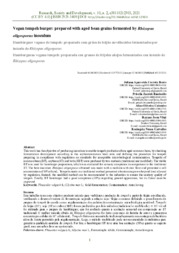Vegan tempeh burger: prepared with aged bean grains fermented by Rhizopus oligosporus inoculum.
Vegan tempeh burger: prepared with aged bean grains fermented by Rhizopus oligosporus inoculum.
Author(s): BENTO, J. A. C.; BASSINELLO, P. Z.; COLOMBO, A. O.; VITAL, R. J.; CARVALHO, R. N.
Summary: This work has the objective of producing inoculum to enable tempeh production from aged common bean, by checking fermentation development according to the soybean/common bean ratio and defining the procedure for tempeh preparing in compliance with regulation on standards for acceptable microbiological contamination. Tempehs of common bean (BT), soybean (ST) and both (SBT) were produced by two methods (traditional and modified). The viable BT was used for hamburger preparation, which was evaluated for sensory acceptance in comparison to the traditional ST. The best inoculum Rhizopus oligosporus obtained was made with a medium with rice flour and presented a cell concentration of 106cells/mL. Tempehs made in a traditional method presented a bacterium grown beyond limit allowed by regulation. Instead, the modified method can be recommended to the industries to ensure the sanitary quality of tempeh. Finally, BT hamburger had a good acceptance (58%) regarding general appearance, but its flavor must be improved.
Publication year: 2021
Types of publication: Journal article
Unit: Embrapa Rice & Beans
Observation
Some of Embrapa's publications are published as ePub files. To read them, use or download one of the following free software options to your computer or mobile device. Android: Google Play Books; IOS: iBooks; Windows and Linux: Calibre.
Access other publications
Access the Agricultural Research Database (BDPA) to consult Embrapa's full library collection and records.
Visit Embrapa Bookstore to purchase books and other publications sold by Embrapa.

